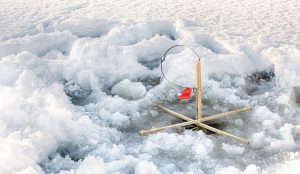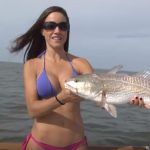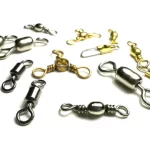Ice fishing is a winter tradition for many anglers, and tip-ups are one of the most effective ways to catch fish in frozen waters. Whether targeting walleye, northern pike, or perch, setting up a tip-up correctly can mean the difference between a slow day and a non-stop bite. Here’s a step-by-step guide to setting up the best tip-up rig for a successful ice fishing trip.
Choosing the Right Tip-Up
Not all tip-ups are created equal, so selecting the best model for the conditions is crucial. Popular choices include:
- Classic Wooden Tip-Ups – Reliable and durable, great for most conditions.
- Thermal Tip-Ups – Designed to cover the hole, preventing ice build-up.
- High-Visibility Tip-Ups – Feature bright flags and sturdy mechanisms for easy bite detection.
For best results, use a thermal tip-up in extremely cold conditions to prevent your hole from freezing over.

Setting Up the Line and Leader
- Spool with the Right Line: Use a heavy-duty braided tip-up line for durability and better handling in freezing temperatures.
- Add a Swivel: Connect the mainline to a fluorocarbon or steel leader using a small barrel swivel. This reduces line twists.
- Choose the Right Leader Length:
- For Walleye & Perch: 6-12 inches of fluorocarbon leader (6-10 lb test).
- For Pike & Muskie: 12-18 inches of steel leader (20-40 lb test).
Hook and Bait Selection
- Treble Hooks (#4 to #6): Ideal for large predators like pike.
- Single Hooks (#6 to #10): Perfect for walleye and perch.
- Live Bait: Minnows, shiners, or sucker fish work best. Hook them lightly behind the dorsal fin for natural movement.
Setting the Depth
- Use a depth finder weight to locate the bottom.
- Adjust bait 1-3 feet above the bottom for walleye and perch.
- Suspend bait 3-6 feet under the ice for northern pike.
Adjusting the Flag Sensitivity
- For aggressive fish like pike, set the flag to trigger with minimal resistance.
- For light-biting fish like walleye, reduce tension so the fish doesn’t feel resistance when taking the bait.
Checking and Maintaining Tip-Ups
- Clear Ice Build-Up: Regularly check your holes for ice formation.
- Refresh Bait: Change live bait every couple of hours to keep it active.
- Monitor Flag Activity: Stay close and respond quickly to any flags that pop up.
A well-set tip-up rig increases the chances of catching fish through the ice while allowing anglers to cover multiple locations at once. With the right setup, strategic bait placement, and frequent monitoring, ice fishing can be an incredibly productive winter sport. Stay warm, stay safe, and get ready for a day of exciting tip-up action on the ice!
Image: overtons





